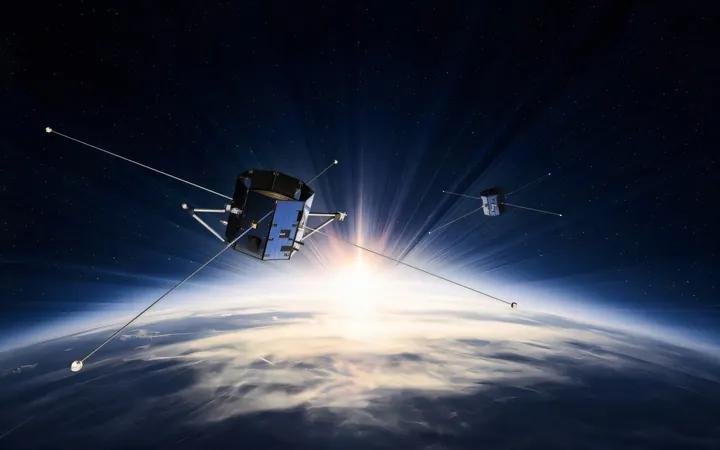
Exciting Breakthrough: NASA's TRACERS Mission Satellites Ready for Launch!
2024-11-13
Author: Daniel
NASA's TRACERS Mission Overview
NASA has recently celebrated a significant milestone in the development of its TRACERS (Tandem Reconnection and Cusp Electrodynamics Reconnaissance Satellites) mission. The completion of the twin spacecraft sets the stage for an eagerly anticipated launch in 2025, marking a pivotal step in our understanding of the Sun's influence on Earth.
Importance of the TRACERS Satellites
What exactly are the TRACERS satellites, and why is their mission important? These two groundbreaking spacecraft are designed to investigate the complex interactions between the solar wind—a continuous stream of charged particles emitted by the Sun—and Earth’s magnetosphere. This magnetic shield protects our planet from harmful solar radiation but can be dramatically affected by solar activity.
Focus on Magnetic Reconnection
One of the primary focuses of the TRACERS mission is to study magnetic reconnection, a process that occurs when two magnetic fields collide and release bursts of energy. This phenomenon is particularly critical at the magnetopause, the boundary where the solar wind meets Earth's magnetic field. During these reconnection events, solar wind particles are propelled into our atmosphere at incredible speeds, leading to stunning displays of auroras, the shimmering lights that dance in the polar skies.
Impact of Space Weather
Understanding space weather is becoming increasingly vital as technology becomes more integrated into our daily lives. Disturbances from space weather can disrupt communication satellites, damage power grids, and pose safety risks to astronauts in orbit. TRACERS aims to shed light on how these cosmic events unfold, helping us navigate and potentially mitigate their effects.
Operation of the Twin Spacecraft
The twin spacecraft will operate in tandem, with one flying behind the other through the polar cusps—regions where Earth’s magnetic field opens near the poles. By collecting data simultaneously from both satellites, scientists will gain unique insights into the dynamics of magnetic reconnection and how it evolves in real-time.
Construction and Testing
Millennium Space Systems, a subsidiary of Boeing, finalized the construction of the two satellites in October 2024. Following this achievement, the integration of the TRACERS instruments is underway, leading to a comprehensive testing phase. Once testing concludes, the satellites will be transported to Vandenberg Space Force Base in California, where they will be prepared for their launch vehicle.
Team Enthusiasm and Progress
Principal Investigator David Miles from the University of Iowa expressed his enthusiasm, saying, “It's exciting to see the TRACERS instruments and the two spacecraft come together. The team is making excellent progress toward launch.”
Successful Review and Future Steps
In addition, the mission passed a critical review—Key Decision Point D—on August 8, 2024, confirming that TRACERS is on track to meet its goal of achieving launch readiness by April 2025. This successful review signifies the transition from the developmental phase to final preparations, including testing and assembly for the upcoming launch.
Collaboration and Inspiration
Skyler Kleinschmidt, the TRACERS program executive at NASA Headquarters, praised the collaborative efforts of the team: “This team has been truly incredible. Building a spacecraft is never easy, but seeing the team work together through all of the challenges that they have encountered is inspiring.”
Looking Ahead: The Future of TRACERS
With the TRACERS mission poised to unlock new secrets about the interaction between the solar wind and Earth’s magnetic field, the scientific community and space enthusiasts are eagerly awaiting what discoveries lie ahead. Stay tuned as NASA embarks on this ambitious journey to better understand our universe!

 Brasil (PT)
Brasil (PT)
 Canada (EN)
Canada (EN)
 Chile (ES)
Chile (ES)
 España (ES)
España (ES)
 France (FR)
France (FR)
 Hong Kong (EN)
Hong Kong (EN)
 Italia (IT)
Italia (IT)
 日本 (JA)
日本 (JA)
 Magyarország (HU)
Magyarország (HU)
 Norge (NO)
Norge (NO)
 Polska (PL)
Polska (PL)
 Schweiz (DE)
Schweiz (DE)
 Singapore (EN)
Singapore (EN)
 Sverige (SV)
Sverige (SV)
 Suomi (FI)
Suomi (FI)
 Türkiye (TR)
Türkiye (TR)